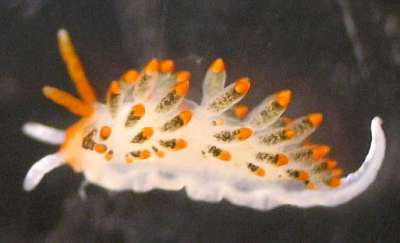
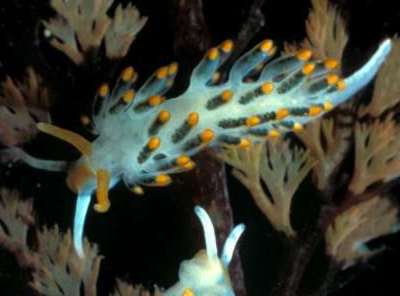
Cuthona lagunae
(O'Donoghue, 1926)
Order: NUDIBRANCHIA
Suborder: AEOLIDINA
Family: Tergipedidae
DISTRIBUTION
Oregon, USA to Baja California, Mexico.
PHOTO
Upper: Montana de Oro, California, USA. Intertidal. Length: 7 mm. 26 May 2005. Rocky shore, low intertidal pool. Photographer: Jeff Goddard.
Lower: San Diego, California. Photo: Jeff Hamann .
Grows to 14mm. Characterised by orange rhinophores and ceratal tips, opaque white oral tentacles and median line on posterior foot, and dark, usually black ceratal digestive gland duct.
-
Behrens, D.W. (1981) Pacific Coast Nudibranchs.
Rudman, W.B., 2000 (July 10) Cuthona lagunae (O'Donoghue, 1926). [In] Sea Slug Forum. Australian Museum, Sydney. Available from http://www.seaslugforum.net/find/cuthlagu
Related messages
Cuthona lagunae from Monterey, CA
February 10, 2006
From: Clinton Bauder
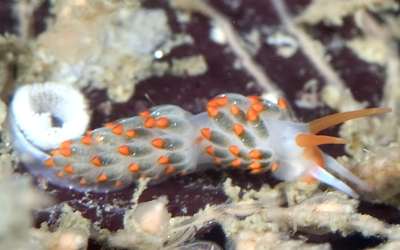
Hi Bill,
Dive buddy Kawika has a new macro lens. Prior to our dive Sat night he instructed me to look for small things to take pictures of; "The smaller the better". In a case of "be careful what you wish for" I found these 5mm long Cuthona lagunae on a patch of hydroids growing on some red algae.
Locality: Tanker Reef, Monterey, California, USA, Pacific coast. 14 meters, 4 February 2006, Shale reef.. Length: 5 mm. Photographer: Kawika Chetron
Clinton
gecko1@apple.com
Bauder, C., 2006 (Feb 10) Cuthona lagunae from Monterey, CA. [Message in] Sea Slug Forum. Australian Museum, Sydney. Available from http://www.seaslugforum.net/find/15771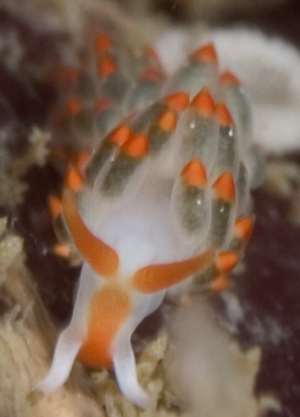
Dear Clinton,
I think someone made the joke earlier about 'point and shoot' photography. You pointing and Kawika shooting proved a very successful way to test the lens
Best wishes,
Bill Rudman
Re: Cuthona fulgens? from California
September 30, 2005
From: Jeff Goddard
Hi Bill,
Concerning message #14852:
I agree with your identification of Steve Lonhart's aeolid as Cuthona lagunae. The orange rhinophores distinguish it from the other NE Pacific species of Cuthona, and the cerata of C. lagunae are tipped with bright orange, have very dark cores and lack the white flecks of C. fulgens.
Best wishes,
Jeff
goddard@lifesci.ucsb.edu
Goddard, J.H.R., 2005 (Sep 30) Re: Cuthona fulgens? from California. [Message in] Sea Slug Forum. Australian Museum, Sydney. Available from http://www.seaslugforum.net/find/14859Thanks Jeff,
Bill Rudman
Re: Cuthona fulgens? from California
September 30, 2005
From: Dave Behrens
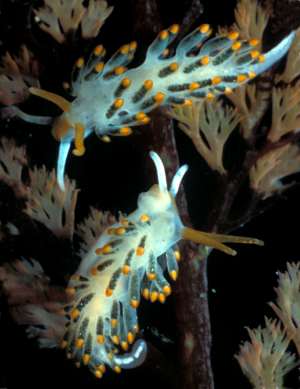
Bill:
Concerning message # 14852:
I tend to agree with you on this ID, although I can't really make out the rhinophores. Here are two photos of C. lagunae. The photo with a pair of specimens [upper & lower right] was taken by Jeff Hamann in San Diego. The single specimen shot [lower left ] is mine from Marin County, California. Both are on bogus substrates.
Dave Behrens
dave@seachallengers.com
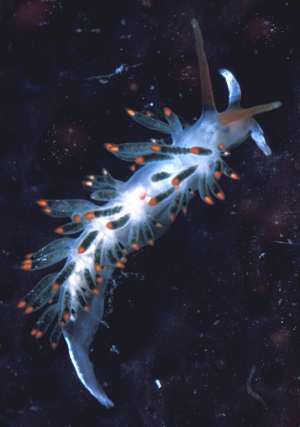
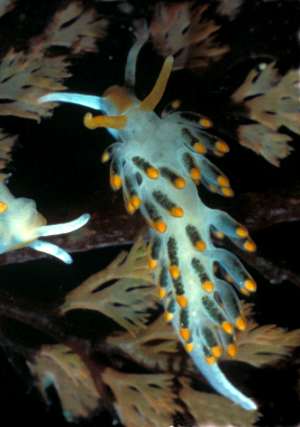
Thanks Dave,
All I need now is a photo of C. fulgens.
Cheers,
Bill Rudman
Cuthona fulgens? from California
September 29, 2005
From: Dr. Steve Lonhart
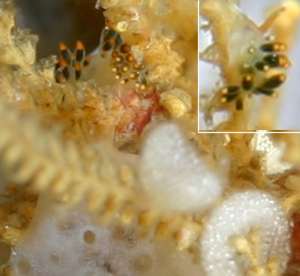
Hello,
On September 15, 2005 I was diving in Point Lobos State Reserve, California, USA. I photographed a hydroid (possibly Sertularella turgida) and after downloading the images noticed slugs laying egg cases.
Locality: Point Lobos State Reserve, California, USA. Depth: 60 ft. Length: 'A few mm'. 15 September 2005. Subtidal rocky reef. Photographer: Steve Lonhart
I've clipped the original photo in the hopes that you can ID the slug in question. Is it Cuthona fulgens? Depth was about 60 ft on a steep rocky reef, high water flow, and tremendous invertebrate cover.
Thanks!
Steve
lonhart@biology.ucsc.edu
Lonhart, S.I., 2005 (Sep 29) Cuthona fulgens? from California. [Message in] Sea Slug Forum. Australian Museum, Sydney. Available from http://www.seaslugforum.net/find/14852Dear Steve,
I would look forward to some confirmation from local experts, but I think this is probably Cuthona lagunae. I don't have a photo of C. fulgens on the Forum (contributions welcome!) but the most obvious difference is that C. lagunae has orange rhinophores and C. fulgens has white. In the inset I put in your photo, the rhinophores appear to be orange. Perhaps you could check that from your originals.
Also Jeff Goddard [message #2697] reports that C. lagunae feeds exclusively on Sertularella turgida, which fits with your hydroid identification. The only feeding record for C. fulgens is the hydroid Sarsia sp. (see Goddard, 1985).
-
Goddard, J. H. R. 1985b. Food habits of some nudibranchs from Cape Arago, Oregon. Western Society of Malacologists Annual Report, 17: 9-10.
Best wishes,
Bill Rudman
Cuthona lagunae from California
June 6, 2005
From: Jeff Goddard
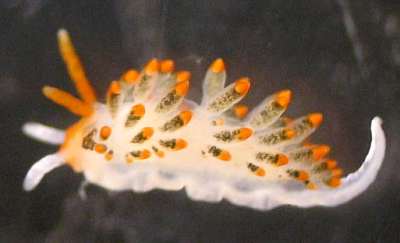
Hi Bill,
Here is a photo of Cuthona lagunae to complement the factsheet for this species, as well as to provide further visible comparison to the Flabellina trilineata pictured in Denise Weisman's message [#13904] (the latter do have unusually dark cerata cores).
Locality: Montana de Oro, California, USA. Intertidal. Length: 7 mm. 26 May 2005. Rocky shore, low intertidal pool. Photographer: Jeff Goddard
This specimen was relaxed in Magnesium chloride and photographed through a dissecting microscope, thus the limited depth of field and somewhat wrinkled appearance.
Best wishes,
Jeff
goddard@lifesci.ucsb.edu
Goddard, J.H.R., 2005 (Jun 6) Cuthona lagunae from California. [Message in] Sea Slug Forum. Australian Museum, Sydney. Available from http://www.seaslugforum.net/find/13958Thanks Jeff,
Bill Rudman
More on the unusual eggs of Cuthona lagunae
June 6, 2005
From: Jeff Goddard
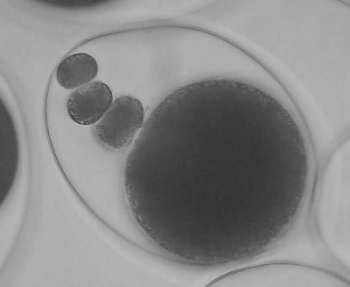
Hi Bill,
Here is a photomicrograph of an uncleaved zygote (fertilized egg) from an egg mass laid by the specimen pictured in my previous message [#13958] on Cuthona lagunae. It shows the unusually large polar bodies previously described from a population of this species from Point St. George in northernmost California. I have also observed these large polar bodies in eggs laid by C. lagunae from the Santa Barbara channel, so they appear to be characteristic of the species. The zygote pictured was about 95 microns in diameter.
These polar bodies are eventually ingested by the embryonic veligers, and no trace of them remains by the time the veligers hatch. The polar bodies of all the other opisthobranchs from the northeast Pacific Ocean that I have observed are typically only a few microns in diameter and contain little or no yolk, and I don't know of any other example of such large polar bodies in an opisthobranch.
Locality: Montana de Oro, San Luis Obispo County, California, USA. Intertidal. Egg, 95 microns in diameter, from adult 7 mm long. 28 May 2005
Rocky shore, low intertidal pool. Photographer: Jeff Goddard
-
Goddard, J.H.R. (2004) Developmental mode in benthic opisthobranch molluscs from the northeast Pacific Ocean: feeding in a sea of plenty. Canadian Journal of Zoology, 82: 1954–1968.
Best wishes,
Jeff
goddard@lifesci.ucsb.edu
Goddard, J.H.R., 2005 (Jun 6) More on the unusual eggs of Cuthona lagunae. [Message in] Sea Slug Forum. Australian Museum, Sydney. Available from http://www.seaslugforum.net/find/13959Dear Jeff,
Your paper is a valuable contribution to our knowledge of the NE Pacific fauna. It gives us an interesting insight into their embryology and larval development.
Best wishes,
Bill Rudman
More on Cuthona lagunae
July 13, 2000
From: Jeff Goddard
Hi Bill,
With regard to your question about observing similar polar bodies in other species of aeolids, I have examined the early development of about 100 species of northeast Pacific opisthobranchs, including 11 species of Tergipididae. Cuthona lagunae is the only one to possess large, yolk filled polar bodies. All the other species have minute, mostly clear polar bodies, usually two in number. Also, shortly before his death, Tom Thompson wrote me saying that he had never seen polar bodies in any organism similar to those found in Cuthona lagunae. It was largely owing to Tom's remarks and words of encouragement that I wrote that paper on Cuthona lagunae.
Earlier this year I was able to observe the embryonic development of Cuthona lagunae collected from Santa Barbara County, California. The eggs and polar bodies produced by these specimens were virtually identical in size and yolk content to those I had previously observed from northern California.
In the upper of Clinton's photos, the hydroid I usually find them associated with, Sertularella, is visible as the darker brown, relatively thick growths with short alternate branches (actually the hydrothecae, or coverings of the polyps) extending above the tail of the slug. It is also visible in this photo as the brown, largely out of focus, stalks in the bottom left.
Best wishes,
Jeff
goddard@lifesci.ucsb.edu
Goddard, J., 2000 (Jul 13) More on Cuthona lagunae. [Message in] Sea Slug Forum. Australian Museum, Sydney. Available from http://www.seaslugforum.net/find/2702Cuthona lagunae - feeding & embryology
July 12, 2000
From: Jeff Goddard
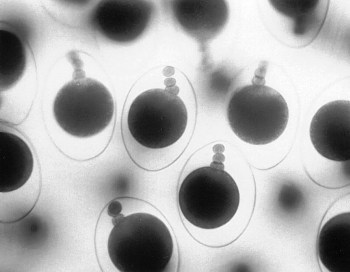
PHOTOS: The uncleaved eggs and polar bodies inside the egg capsules of Cuthona lagunae. The eggs in this particular egg mass averaged 102 microns in diameter. (see below for photos at higher magnifications).
Hi Bill,
The aeolids in Clinton Bauder's photos are definitely Cuthona lagunae. As you correctly point out, the combination of white cephalic tentacles, orange rhinophores and patch on the head, white stripe on the tail, and green and orange cerata is distinctive.
In southern Oregon and northern California I have consistently found Cuthona lagunae on the thecate hydroid Sertularella turgida (see Goddard, 1987, personal observations), which appears to be present slightly below and to the left of the specimen in Clinton's lower photo. I have not, however, actually observed feeding by the aeolid on this hydroid.
This is one of my favorite aeolids, owing to its conspicuous color pattern and interesting embryonic development. Shortly after egg laying and fertilization, the eggs of Cuthona lagunae extrude some of the largest polar bodies known in the animal kingdom (see attached photos). These eventually detach from the developing embryos and are later ingested whole by the embryonic veligers prior to hatching (Goddard, 1991 and unpublished observations). The polar bodies thus constitute a unique source of extra zygotic yolk. The function, if any exists, of this yolk is unknown, but it may accelerate embryonic development slightly by reducing the amount of yolk which must be cleaved by the embryo, or perhaps "prime" the embryonic veligers for feeding in the plankton.
Like other members of the Tergipedidae (but in contrast to most other nudibranchs), the planktotrophic veligers of Cuthona lagunae hatch with egg shaped shells that do not increase in size during the larval stage. Rather, the tissues of the veliger grow to fill the initially spacious shell.
References:
• Goddard, J. H. R. (1987) Observations on the opisthobranch molluscs of Punta Gorda, California, with notes on the distribution and biology of Crimora coneja. The Veliger, 29(3):267-273.
• Goddard, J. H. R. 1991. Unusually large polar bodies in an aeolid nudibranch: a novel mechanism for producing extra-embryonic yolk reserves. Journal of Molluscan Studies, 57 (supplement):143-152
Best wishes,
Jeff
goddard@lifesci.ucsb.edu
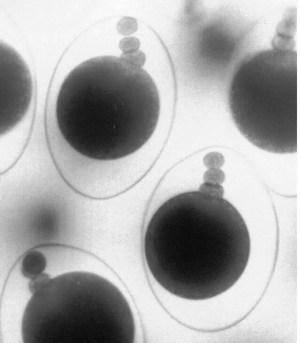
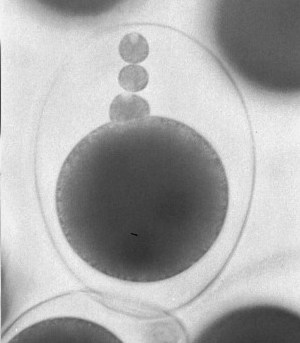
Dear Jeff,
Thanks for the interesting photos and observations on the strange polar bodies in this animal. I remember your paper in the Tom Thompson memorial supplement to the Journal of Molluscan Studies. Have you had a chance to check any other species for a similar phenomenon?
Best wishes,
Bill Rudman.
Cuthona lagunae? from California
July 11, 2000
From: Clinton Bauder
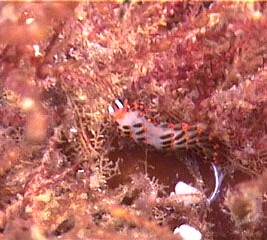
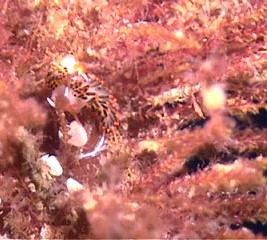
Hi Bill,
This is probably a Dave Behrens question but if anybody else can help I'd love to hear from you...
While diving yesterday near Yankee Point, California (just south of Carmel) I came across some interesting nudibranchs. I was diving in about 90 feet (30M) of water on a rocky bottom. Near the end of my dive I noticed a Macrocystis kelp stalk which was covered in hydroids. My instinct was "Hey - that's a great place to look for nudibranchs" and boy did I find them! There were dozens of small (4-8mm) aeolids apparently grazing on the hydroids. At first they looked like Flabellina trilineata but a closer inspection revealed that they were something else.
From Dave Behrens' book I'm guessing Cuthona lagunae but I'm not sure. They appear to have white oral tentacles, smooth orange rhinophores and dark green cerata tipped with bright orange. The tail is marked with a white stripe.
I apologize for the frightfully bad jpegs but the branchs were small, my lens wide angle and my bottom time limited! In any case am I on the right track here?
Clinton
gecko1@apple.com
Bauder, C., 2000 (Jul 11) Cuthona lagunae? from California. [Message in] Sea Slug Forum. Australian Museum, Sydney. Available from http://www.seaslugforum.net/find/2693Dear Clinton,
I'm sure Dave Behrens will let us know if we are mistaken, but I agree with your identification of Cuthona lagunae. The orange rhinophores, white oral tentacles and white median line on posterior end of foot seem very distinctive, and certainly stand out in your photos.
Best wishes,
Bill Rudman.
